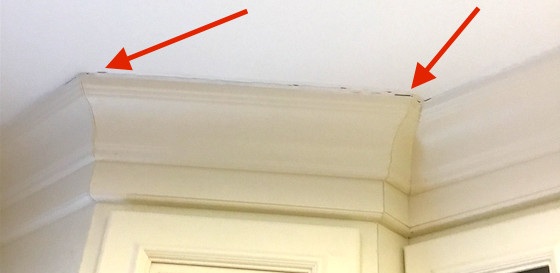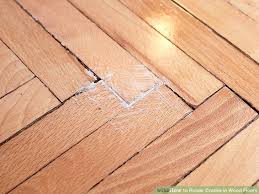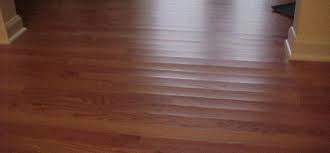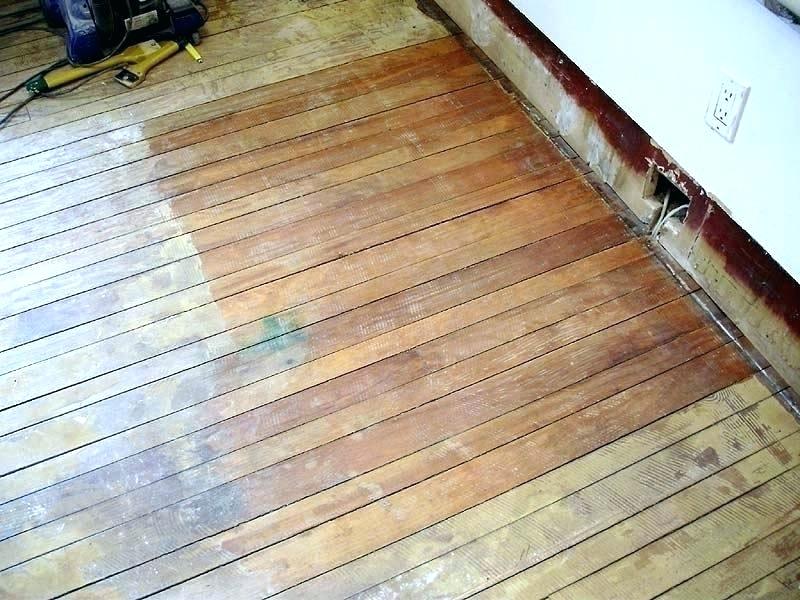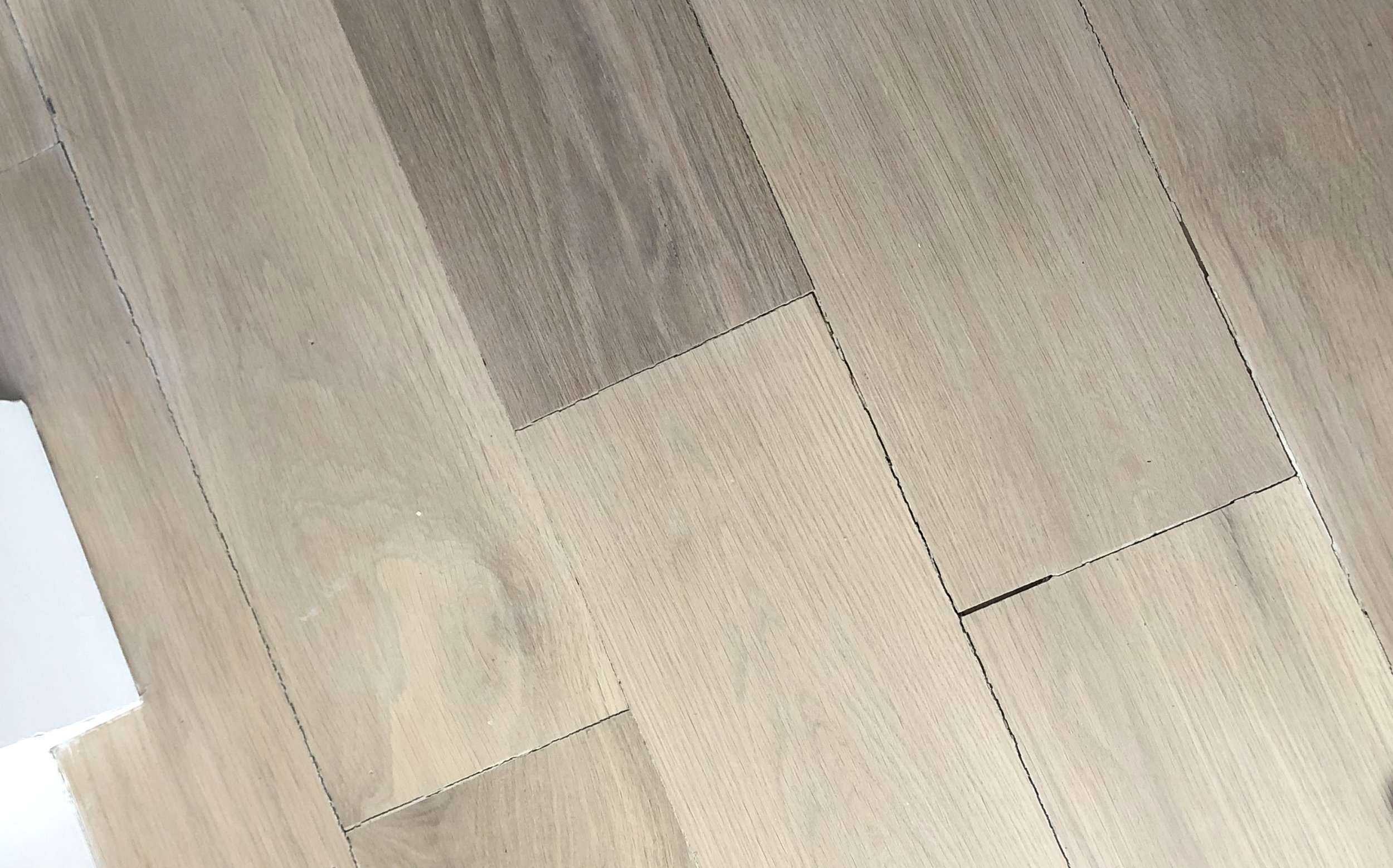This is the time of year when I get lots of calls and messages about gaps in floors. Not just from our customers, but from people all over the country! Why do floors look beautiful and perfect when they are newly installed and then some separation between boards occurs down the road? Why do old wood floors that looked good in summer then separate and creak in the winter?
Let’s go back to the source of wood flooring: the tree. Remember your hardwood floor was once a tree, right? Wood flooring is an organic material, meaning it comes from nature. Our favorite NWFA (National Wood Flooring Association) t-shirts proudly proclaim “Nature Creates, We assemble.” Trees absorb water and moisture up through the trunk from the roots, and trees can withstand long periods of low moisture, but the cells of the wood will be drier and shrink up with this lower moisture content. Guess what? When you cut the tree down into wood floor boards, they are still wood, still organic, still able to absorb and retain moisture, and that is exactly what they do. Wood floors will “move,” meaning expand and contract, throughout their lifetime.
That’s right! Your wood floor was once a tree. :)
Nash Valenti and Phil Valenti at NWFA Inspector School & Training at NWFA Headquarters in Chesterfield, MO. Nash is modeling our fav NWFA T-shirt.
When wood absorbs moisture, it expands, or swells up, and when it loses moisture, it shrinks, or contracts. Wood flooring responds to the conditions immediately surrounding it. It takes in moisture from the air in your home, or loses it if the Relative Humidity (RH) of the home drops. What is Relative Humidity? Relative humidity is the amount of water vapor that is in the air, expressed as a percentage of the maximum amount of water the air can hold at the same temperature. Warm air holds more water than cold air, so hot days are typically far more humid than cold days. In winter, the air outside is generally dry and cold and the RH inside of people’s homes drops, which is why I get more calls about this issue at this time of year. Not only do RH swings affect wood flooring, but they can also affect cabinetry and trim.
Wood molding also responds to moisture fluctuations!
Check out your moldings in greater detail if your floor is gapped…
Base molding is also made of wood - if you think your floor was not installed correctly but your molding is separating, you probably have a moisture problem in your home!
Cold winter months require more heating. Dry air is forced into the environment. Moisture is now removed from not only the environment but the cells or pores of the hardwood. Contraction occurs. Ventilation also plays a major role in this winter-time drying. When you bring cold outside winter air into a house and then warm it up, the RH of that air drops significantly. Old, leaky homes with old windows will present a real challenge keeping the RH inside the home at a constant level. Oftentimes people don’t realize how dry the air in their house becomes in winter!
If this is your old house, you will have problems with every kind of hardwood flooring. LOL
Lovely old home where we did a major flooring project in Centre Island, NY. These older homes are gorgeous and have a lot of character, but it is common to have problems with excessive ventilation!
Now that we know what causes wood flooring to gap (shrink), how do we prevent this from occurring? If you can maintain a constant relative humidity and temperature in your home, you will see much less floor movement. The NWFA teaches us that, “If you change the conditions, you change the dimensions.” Dimensions refers to the actual dimensions (measurements) of the individual boards themselves. Maintaining constant conditions in the home is critical to the success of a hardwood floor. If you have wood flooring in your home in NY and you turn off the heat entirely while you go off to your winter home in Florida, you will return home to a house full of large gaps, and possibly cracked and split boards! On the flip side, if you live in Florida and go away for a long summer vacation to NY and turn off all the air conditioning in your home while you are away, you are likely to return to a cupped, or rippled floor.
Once you make the commitment to wood flooring in your home, you are making the commitment to keeping the conditions of the home somewhat constant, year-round, whether you are in the home or not. If you don’t want to run the A/C, at least turn the switch on your thermostat to FAN ON, which will keep air moving through the house continuously. Remember that ventilation decreases RH. Some examples of common flooring issues that are a result of dramatic swings in RH:
The acceptable RH range for wood flooring in the Northeast USA is between 30% - 50%. If the RH in your home is below 30%, you can be certain that you will see gaps in your wood flooring, and probably cracks as well! Humidity controls can be installed in your HVAC system to control the RH level, which can greatly improve the low RH that most people experience in their homes in the winter time. If you don’t have an HVAC system, Humidifiers can help to bring up the RH inside the home in the winter. Humidifiers are not a permanent solution to winter-time dryness because a high interior RH when it is very cold outside can be bad for a home as it can lead to condensation and mold formation. Some simple ways to at least increase the RH levels in your home in the winter are to leave the dishwasher open after running it, and after showering, to leave the bathroom door open! If you have problems with excessive ventilation (lots of air entering home from outside), weatherization and home energy audits can help to identify leaky areas, and they will suggest sealing efforts to reduce ventilation and the drying effect it has in the home in winter.
Purchase an inexpensive hygrometer to keep track of the Relative Humidity (RH) in your home!
At the end of it all, hardwood flooring is made from wood, an organic material, and science is science. There is no way to prevent winter and there is no way to prevent wood from losing some moisture in the winter. While there are things we can do to improve the conditions that cause seasonal gapping, we cannot eliminate them completely.
If you are lucky enough to be planning a new floor installation, keep these things in mind when making your selection. Some species are more dimensionally stable than others. Maple and Hickory expand and contract more than Oak or Pine under the same conditions. Wider planks will move more than smaller, skinnier boards. Wider boards have a greater surface area, and thus they will expand and contract more dramatically as conditions in the home change. A 5-inch-wide plank will shrink twice as much as a 2¼-inch-strip. So the size of the gap between 5-inch boards will be twice as big as the gap between 2¼-inch boards.
Other types and cuts of flooring such as Engineered Flooring or Rift & Quarter Sawn flooring are more dimensionally stable than others. We install a lot of wide plank Engineered flooring because it’s a pretty safe bet to be looking great year-round with minimal movement. Where you live and the specific conditions of your home should always be a factor in selecting species and board width. Do gaps really bother you? Select a very stable species and cut, such as Rift and Quarter Sawn Oak, with a narrow plank width for the best results. If you don’t care about gaps, go for that wide plank Hickory floor that you’ve always wanted! Keep these things in mind when selecting a new floor – expectations should be in line with reality. If you choose a wide plank Maple floor and you live in Minnesota, you should expect to see big seasonal gaps in the winter!
7” Engineered White Oak Hardwood flooring that we installed & finished with Woca penetrating oils in Amagansett, NY in 2016. This picture was taken more than a year later and look! There is hardly any separation in the floor.
If you own an old house that had old, gapped flooring when you purchased it, there is not really too much to do about it unless you want to rip out the floor and install a new one. Incorrect nail spacing, improper acclimation and species/board width selection all can contribute to seasonal gapping and floor movement, all of which which you cannot do anything about if you have purchased a home with existing hardwood flooring.
This is a stunning home we sanded and finished in Sagaponack, NY. The homeowner inherited these 4” Red Oak hardwood floors when the home was purchased. Note that climate controls were turned off in the winter prior to our arrival in Spring and the floor exhibits significant gapping.
Wood filler is not a cure for gaps. Don’t forget that your wood floor will continue to move throughout its lifetime. The wood filler will dry hard and will look good at first, but then when your floor begins to expand in the warmer, more humid months of summer, that woodfiller will crack and will look like kitty litter between the boards. In our professional opinion, if your old wood floor has gaps, just live with them. They will look worse if you fill them and the wood filler cracks. Try to bring up the humidity in your home or wait for summer to come around to see them close up a bit.
Here you can see wide plank White Oak flooring that had the gaps filled with wood filler (not by our team)…now the wood filler appears cracked and jagged in the gaps, which in my opinion looks worse than just a gap.
See how woodfiller cracks in between the boards?
Beautiful Red Oak floor we sanded and finished in East Hampton New York with Jacobean stain and oil poly in winter 2015. You can see some slight hairline gaps - we did not fill them. They will close up again in summer.
I hope that this blog post has been helpful to everyone with questions about gaps in their wood floors. Don’t forget part of the charm of wood flooring is its imperfect nature!




